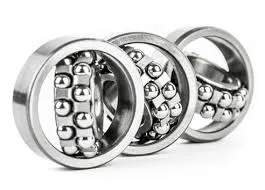
Nov . 26, 2024 03:58 Back to list
tapered bearing race
Understanding Tapered Bearing Races Design, Function, and Applications
Tapered bearing races are critical components in many mechanical systems that require the smooth and efficient transfer of loads. These specially designed bearings are most commonly found in applications that involve rotating machinery, such as vehicles, heavy equipment, and various industrial applications. This article delves into the design, function, and significance of tapered bearing races, highlighting their contributions to modern engineering.
Design of Tapered Bearing Races
A tapered bearing race consists of an inner and outer ring that are conically shaped. This design allows the bearing rollers or balls to make contact with the race at a specific angle, which distributes the load more evenly across the surface area. The tapered shape not only enables the bearings to support axial (thrust) loads but also radial (rotational) loads. This dual-load capability makes tapered bearings versatile and suitable for various applications.
The materials used in the construction of tapered bearing races are also significant
. Typically, they are made from high-carbon chromium steel, which provides durability and resistance to wear. Advanced materials like ceramic or composite materials may also be used in specialized applications where high temperatures or corrosion resistance are factors.Functionality of Tapered Bearing Races
Tapered bearings function by allowing rotational movement while minimizing friction. When a load is applied to a tapered bearing race, the contact between the raceway and rolling elements creates a rolling motion rather than sliding. This rolling action reduces wear and energy loss, making the system more efficient. Additionally, the tapered design accommodates both radial and axial loads, making it ideal for applications with complex load requirements.
tapered bearing race

The angle of the tapered raceway is crucial because it determines the bearing's load-carrying capacity and its ability to handle axial loads. By adjusting the angle, designers can tailor the performance characteristics of the bearing to meet specific application needs. For example, a steeper angle provides greater axial load capacity, while a shallower angle is better for handling more radial loads.
Applications of Tapered Bearing Races
Tapered bearing races are found in numerous applications across many industries. One of the most common uses is in the automotive sector, where they are integral to wheel hubs. Here, they help support the vehicle's weight and facilitate smooth wheel rotation. They are also used in trailer axles and differential gears, contributing to the durability and functionality of these systems.
In industrial machinery, tapered bearings are employed in gearboxes, conveyors, and other rotating equipment. By ensuring precise alignment and minimal friction, they enhance the overall efficiency and longevity of these machines. Additionally, tapered bearing races are common in aerospace applications, where they help manage the high loads and stresses associated with flight.
Conclusion
Tapered bearing races are essential components that enhance mechanical systems' performance and durability. Their unique design allows them to handle combined radial and axial loads effectively, making them versatile for various applications. Understanding their functionality and applications helps engineers and technicians select the appropriate bearings for their specific needs. As technology continues to advance, the design and materials used in tapered bearing races will likely evolve, further improving their efficiency and performance in the ever-demanding world of engineering.
Latest news
-
Premium Deep Groove Ball Bearings | High Speed & Reliability
NewsAug.29,2025
-
Durable Scaffolding Clamps - Secure & Reliable Tube Connectors
NewsAug.28,2025
-
Common Failures in Thrust Ball Bearings and Solutions
NewsAug.22,2025
-
How Tapered Roller Bearings Can Take Shock Loads
NewsAug.22,2025
-
Angular Bearings in High-Precision Spindles
NewsAug.22,2025
-
The Impact of Misalignment on Cylindrical Roller Bearing Performance
NewsAug.22,2025
